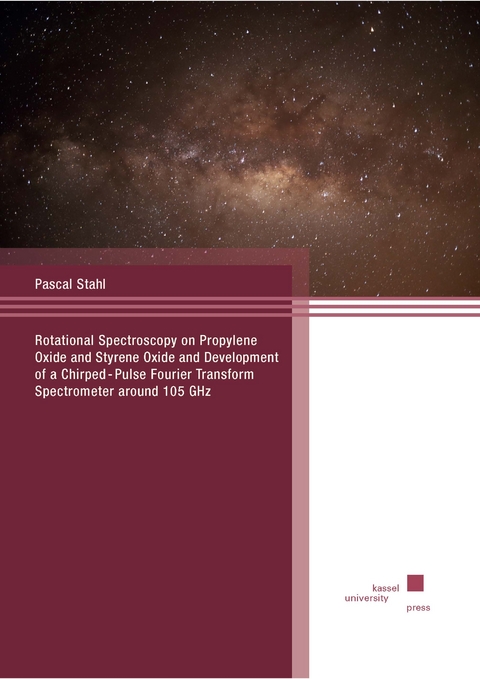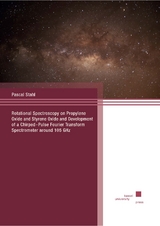Rotational Spectroscopy on Propylene Oxide and Styrene Oxide and Development of a Chirped-Pulse Fourier Transform Spectrometer around 105 GHz
Seiten
2022
Kassel University Press (Verlag)
978-3-7376-1057-5 (ISBN)
Kassel University Press (Verlag)
978-3-7376-1057-5 (ISBN)
Over the last 60 years, the developments and accomplishments in radio astronomy and molecular astrochemistry have gone hand-in-hand with those of high-resolution rotational spectroscopy and high frequency technology. As of today, about 250 molecules have been found in space by their unambiguous characteristic spectral fingerprints. The majority of the already detected interstellar molecules was identified by the comparison of laboratory data fromhigh-resolution spectrometers operating in the microwave, millimeter wave, and sub-millimeter wave region with the observational spectra that were obtained from radio telescopes. Thus, the acquisition of high-resolution laboratory data and the development of efficient spectrometers to record these spectra are mandatory in order to elucidate the stunning phenomena that can be observed in space. One of the main aims of this work was to develop a high-resolution chirped-pulse Fourier transform spectrometer operating in the millimeter wave region that is able to record rotational spectra of molecules of astrophysical relevance. A variety of concepts and techniques of state-of-the-art chirped-pulse spectrometers and superheterodyne receivers such as segmenting, frequency conversion and mixing, and pulse switching were incorporated into the instrument. The developed spectrometer is an automatised high-resolution chirped-pulse Fourier transform spectrometer that operates between 100–112.5 GHz. It employs a powerful millimeter wave radiation source with an output power of up to 1W(30 dBm). The mean noise temperature of the receiver was characterised by a hot-cold measurement to be about 1153 K. Several molecular spectra were recorded in a room-temperature cell and with supersonic jets withmultipass reflection optics. The spectra exhibit reasonable signal-to-noise ratios and a high frequency accuracy. The results demonstrate that the newly built spectrometer iswell suited to study molecules of astrochemical relevance. Furthermore, this work aimed for the laboratory investigations of the chiral complex organic molecules styrene oxide and propylene oxide in order to disentangle their dense spectra and to enable astronomers to search for rotational signatures of these molecules in space. High-resolution chirped-pulse Fourier transform and 2f modulation spectroscopy from the microwave up to the sub-millimeter wave region were employed to record the spectra of these molecules. Quantum chemical anharmonic frequency calculations were carried out to complement the experimental analysis. Styrene oxide is a promising candidate to be detected in space as other aromatic compounds and oxiranes have already been found in the interstellar medium. In this work, the vibrational ground state of styrene oxide was investigated between 2–330GHz. Moreover, the three energetically lowest vibrationally excited states À45, À44, and À43 as well as the singly substituted 13C and 18O isotopologues were characterised. The accurate line lists up to the sub-millimeter wave region that are predicted from the rotational parameters from this work enable astronomers to search for styrene oxide in space. In the case of its detection in warmer regions, the results of the vibrationally excited states will further help to disentangle the dense spectrum. Propylene oxide has already been found towards our galactic centre in its vibrational ground state. This molecule exhibits a hindered internal rotation from its methyl group resulting in a complicated spectrum. Previous to this work, the excited torsional states have not been described in detail and have required further analyses. Therefore, the first excited torsional state of propylene oxide was investigated between 75–950GHz considering the large A-E splittings due to the internal rotation. The applied asymmetric top Hamiltonian includes rotational, structural, and tunnelling parameters that allow to accurately describe the line splitting. Additionally, the barrier height to internal rotation was determined to be V3 Æ 898.6611(894)cm¡1. The results of this work further disentangle the dense spectrum and enable searches for signatures of this excited torsional state in space. Moreover, the doubly deuterated isotopologue of propylene oxide, CH3CHCD2O, was characterised in its ground state between 83–330GHz. The results show that the substitution with deuterium did not only affect the structure of propylene oxide but also the barrier height. Overall, this work contributes to the research fields of laboratory astrophysics and astrochemistry by the development of a new chirped-pulse Fourier transform spectrometer around 105GHz aswell as by providing high-resolution spectroscopic data of styrene oxide and propylene oxide. The latter enables searches for these species in space that possibly results in a deeper understanding of their contribution to astrochemistry.
| Erscheinungsdatum | 01.09.2022 |
|---|---|
| Verlagsort | Kassel |
| Sprache | englisch |
| Maße | 170 x 240 mm |
| Gewicht | 402 g |
| Themenwelt | Naturwissenschaften ► Physik / Astronomie ► Astronomie / Astrophysik |
| Schlagworte | Chirped-pulse Fourier-Transform Spectroscopy • Internal Rotation • laboratory astrophysics • molecular physics |
| ISBN-10 | 3-7376-1057-6 / 3737610576 |
| ISBN-13 | 978-3-7376-1057-5 / 9783737610575 |
| Zustand | Neuware |
| Haben Sie eine Frage zum Produkt? |
Mehr entdecken
aus dem Bereich
aus dem Bereich
Grundlagen, Anwendungen in Astrophysik und Kosmologie sowie …
Buch | Softcover (2022)
Springer Spektrum (Verlag)
49,99 €
die Geschichte und Erforschung unserer Galaxie
Buch | Hardcover (2023)
C.Bertelsmann (Verlag)
30,00 €
Von Hubble-, James-Webb- und anderen Großteleskopen bis zu …
Buch | Softcover (2024)
Springer (Verlag)
22,99 €




